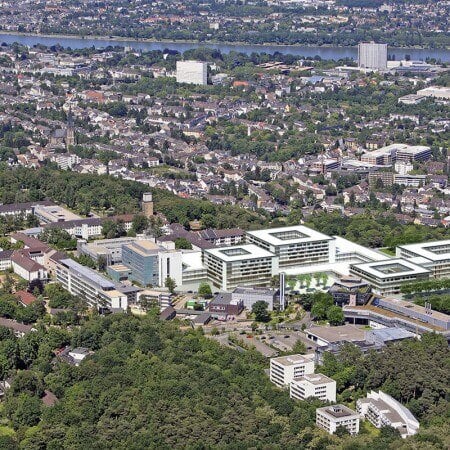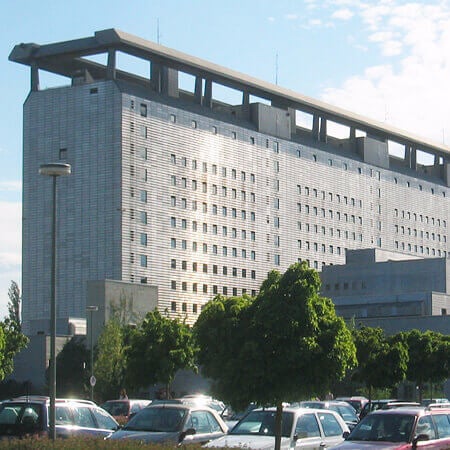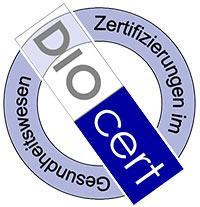Patellar dislocation is the result of injury or congenital pathological changes in the knee tissues. Countries with advanced medicine use both conservative and surgical methods for the treatment of the disease. Some surgical interventions are performed using minimally invasive techniques, with arthroscopy. Although the dislocation can be reduced on its own, without timely treatment, its recurrence is highly likely. Moreover, a patient may develop knee instability or patellofemoral arthrosis, which is the destruction of cartilage and bone tissue of the patellofemoral joint.
To get reliable treatment results without complications, you can go abroad, to one of the countries with advanced medicine. European specialists successfully cope with even the most severe knee pathologies, including dysplastic patellar dislocation and concomitant knee injuries.
Content
- Traumatic patellar dislocation
- Treatment of traumatic dislocation
- Dysplastic patellar dislocation
- Treatment of dysplastic patellar dislocation
- Arthroscopic interventions
- Why is it worth undergoing treatment abroad
- Treatment in Europe at an affordable price
Traumatic patellar dislocation
Patellar dislocation accounts for about 10% of knee injuries. The main group of patients is children and adolescents. The injury often results in chronic knee instability or recurrent dislocation.
In 90% of cases, the mechanism of injury is indirect. The person unsuccessfully turns the knee, which results in a dislocation. In only 10% of cases, the dislocation of the patella occurs due to a direct blow to the knee.
Approximately half of the patients sustain injuries while playing sports. The rest suffer injuries when doing physical work. The injury can sometimes occur even without significant load.
The patella does not always have to be reduced. In about half of the patients, it can be reduced on its own. However, the patient starts feeling pain, has blood accumulated in the knee, and develops edema, which requires medical care. If left untreated, the dislocation recurs, so patients require prolonged immobilization of the limb, and sometimes even surgical stabilization.
The main methods of diagnosing any knee injuries are X-ray and MRI. Although the very fact of patellar dislocation can be established even with the use of clinical methods, it is important to assess the condition of the knee cavity in order to exclude other injuries, such as separation of bone and cartilaginous fragments, meniscus and ligament tears.
Treatment of traumatic dislocation
There are two main approaches to treatment:
- Conservative therapy.
- Early surgical stabilization of the patella.
In case of primary dislocation, preference is given to conservative therapy. Studies show that the results of such an approach are comparable to early surgical stabilization. The recurrences of injury after conservative treatment occur in only 15% of patients.
Conservative treatment includes the following measures:
- Mild fixation of the knee joint or rigid immobilization for up to 6 weeks.
- Drug therapy to eliminate pain, swelling, and inflammation.
- Rehabilitation, which may include physiotherapy procedures, massage, therapeutic exercises.
In the first 5-7 days, knee swelling and pain persist. Initially, blood accumulates in the knee (hemarthrosis). To remove it, a joint puncture is performed. The doctor inserts a needle to remove blood and inflammatory fluid. Pain killers are injected into the knee. During the first days, cold and anti-inflammatory drugs are used to relieve pain and swelling. The patient is accurately monitored, and, if required, doctors perform the second joint puncture.
Different physicians use different tactics for managing patients with patellar dislocation. The therapy may involve either mild fixation or rigid immobilization of the limb. Each tactic has advantages and disadvantages. With mild fixation of the knee, the patient has greater freedom of movement and better tolerates treatment. However, recurrences of patellar dislocation occur 3 times more often. Some of them are due to non-compliance with recommendations for limiting knee movements. With rigid immobilization, recurrences are less common, but the risk of contracture (joint stiffness) formation increases by 2 times, and the recovery takes longer due to atrophy of the muscles of the lower extremity.
The main indication for surgical treatment is recurrent patellar dislocation. It is especially common in patients under 15 years of age. Such a dislocation is called recurrent. If the patella is not strengthened, then the probability of recurrent injury reaches 50%.
Even in case of primary patellar dislocation, doctors sometimes prefer to perform surgical stabilization. This treatment option is preferable for the following patients:
- Those with high physical activity and, accordingly, with a high risk of recurrent patellar dislocation.
- In the presence of free bone and cartilage fragments from the articular cavity.
- In case of persistent instability after patellar reduction.
Dysplastic patellar dislocation
Congenital patellar dislocation is a pathology that develops due to dysplasia of the musculoskeletal structures. As a result, the patella becomes unstable and can be easily dislocated even with minor exposure. This is a rare injury, but it causes severe suffering to patients. The treatment mainly involves the use of surgical interventions.
Congenital patellar dislocation is often combined with other orthopedic pathology, and is also part of the symptom group of many orthopedic syndromes and undifferentiated connective tissue dysplasia, including the following diseases:
- Hip dysplasia and congenital hip dislocation.
- Congenital idiopathic scoliosis.
- Larsen syndrome.
- Pes planovalgus.
According to the clinical course, patellar dislocation can be:
- Permanent.
- Persistent (transient).
Grades:
- Grade 1 – the patella slips only when the knee is bent more than 60 degrees (dislocation does not occur when walking).
- Grade 2 – slipping occurs when the knee is bent up to 20-60 degrees (dislocation occurs only in the second phase of leg flexion when walking).
- Grade 3 – almost the entire walking cycle is accompanied by dislocation of the patella.
- Grade 4 – the patella is dislocated, even with a straight leg, it is located on the femoral condyle.
Treatment of dysplastic patellar dislocation
For the first time, surgical treatment of patellar dislocation was carried out in 1842. The surgery was carried out by Guerin. The essence of the intervention was subcutaneous dissection of the caput laterale of the quadriceps.
As of today, more than 150 methods of surgical treatment of patellar dislocation have been developed. Doctors perform operations on the bones, muscles, as well as combined interventions. The type of surgical treatment is determined depending on:
- Grade of the dislocation.
- Severity of arthrosis in the area of contact of the patella with the femur.
- Grade of dysplasia (underdevelopment) of the anatomical structures in the knee joint.
- Condition of the knee muscles, ligaments, capsules.
- Preferences and experience of the doctor, and the technical capabilities of the hospital.
Bone interventions involve medializing the tibial tuberosity. It can be supplemented by medialization (inward displacement) of the patient's own patellar ligament according to the Goldthwait technique with lateral (external) dissection of the ligamentous apparatus. With recurrent dislocation, the best results can be obtained by strengthening the medial support structures in combination with the displacement of the patella's own ligament.
Most muscle and fascia surgical procedures involve giving the rectus femoris a medial (inward displacement) position.
It is possible to fix the patella in the middle position by suturing the muscles to its upper edge: semitendinous, semimembranous, gracilis, sartorius, adductor. The surgery can be performed with or without lavsanoplasty. Lavsanoplasty involves the use of a lavsan tape. Although tendon and muscle plastic surgery is a sparing treatment, the risk of recurrence after such surgical interventions is higher. Some doctors perform operations to strengthen the rectus muscle with pedunculated flaps. The most common among these operations are the Campbell and Krogius techniques. Surgeons in Europe perform them not in the classical version, but according to modified techniques.
The Crogius method is used only for mild patellar dislocations. It can be used alone or in combination with other methods of dissection of the tendon and ligamentous apparatus from the outside of the patella. In recurrent dislocation, a closed dissection of the lateral supportive ligament is carried out.
Arthroscopic interventions
Most surgical procedures for patellar dislocations, especially severe ones, are performed with an open surgical approach. Doctors make a large incision in the patient's leg – up to 10 cm.
However, such operations are quite traumatic. The recovery period after them is long, patients suffer more from pain, and large scars remain on the leg. The possibility of minimally invasive treatment (through punctures in the knee area) seems attractive for most patients. In recent years, arthroscopic surgery for patellar dislocation is being used more and more often, but it cannot be performed in all patients. Such interventions can be carried out only for mild dislocations.
Doctors perform lateral (external) dissection or medial strengthening of the ligamentous apparatus. A combination of these two techniques is possible. The treatment method is often used for primary dislocation. It reduces the risk of recurrent dislocation. In addition, the likelihood of complications is reduced by half. Patients recover faster and suffer less pain in the postoperative period.
Why is it worth undergoing treatment abroad
Treatment in countries with advanced medicine is safe for health, minimally traumatic and reliable. It is carried out without pain or with minimal discomfort. Patients recover quickly and the risk of recurrent patellar dislocation is low. Concomitant defects, which are often observed in the dysplastic form of pathology, can be corrected simultaneously.
Congenital patellar dislocation is more difficult to treat. However, even with this type of the disease, the best hospitals in the world achieve good treatment results in 97% of cases. For comparison, in countries with poorly developed medicine, the proportion of effective surgical interventions is only 70-80%.
There are several reasons for you to undergo patellar dislocation treatment abroad:
- High-precision diagnostics: it allows the doctors to find out the causes of knee pain after an injury in order to perfectly plan the treatment process.
- In the case of primary patellar dislocation, doctors use effective methods of conservative treatment, which minimize the risk of recurrent dislocation and avoid traumatic knee surgery.
- If surgical treatment is required, then, if possible, it is carried out using arthroscopy – through several punctures in the knee instead of a large incision.
- Minimal risk of complications and rapid recovery of the patient.
- It is possible to simultaneously treat several knee injuries at once (within a single intervention), for example, patellar dislocation, meniscus tear, knee ligament tear.
- Reliable treatment, which minimizes the risk of recurrent patellar dislocation even in professional athletes.
- Well-performed pain management during surgical interventions, elimination of knee pain and other symptoms after surgery.
- Comprehensive rehabilitation allows patients to restore knee function in the shortest possible time in order to return to an active life or sports.
- Safe treatment of children with congenital patellar dislocation and concomitant orthopedic pathologies.
Treatment in Europe at an affordable price
To undergo patellar dislocation treatment in one of the European hospitals, please use the services of the Booking Health company. On our website, you can see the cost of treatment in different hospitals and compare prices in order to book a medical care program at a favorable price. The treatment of patellar dislocation in a European hospital will be easier and faster for you, and the cost of treatment will be lower.
You are welcome to leave your request on the Booking Health website. Our specialist will contact you and provide a free consultation on treatment in Europe. Booking Health will organize your trip abroad. We will provide the following benefits for you:
- We will select a hospital for treatment in Europe, whose doctors specialize in the treatment of patellar dislocation and achieve the best results.
- We will take care of the language barrier and help you establish communication with your attending physician.
- We will reduce the waiting time for the medical care program. You will undergo treatment on the most suitable dates.
- We will reduce the price. The cost of treatment in European hospitals will be lower due to the lack of overpricing and additional coefficients for foreign patients.
- We will take care of all organizational issues: we will draw up the documents, meet you abroad and take you to the hospital, book a hotel, provide interpreting services.
- We will prepare a medical care program and translate medical documents. You do not have to repeat the previously performed diagnostic procedures.
- We will help you keep in touch with the hospital after treatment in Europe.
- We will arrange additional examination and treatment in a European hospital, if required.
- We will buy medicines abroad and forward them to your native country.
The world's leading doctors will take care of your health. The Booking Health specialists will help reduce the cost of treatment, organize your trip, and you will only have to focus on restoring your health.
Authors: Dr. Nadezhda Ivanisova, Dr. Sergey Pashchenko



















